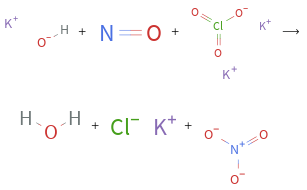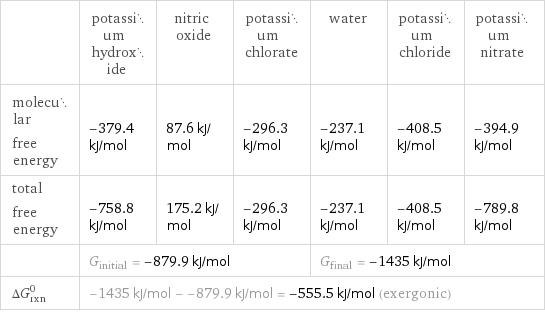Input interpretation

KOH potassium hydroxide + NO nitric oxide + KClO_3 potassium chlorate ⟶ H_2O water + KCl potassium chloride + KNO_3 potassium nitrate
Balanced equation

Balance the chemical equation algebraically: KOH + NO + KClO_3 ⟶ H_2O + KCl + KNO_3 Add stoichiometric coefficients, c_i, to the reactants and products: c_1 KOH + c_2 NO + c_3 KClO_3 ⟶ c_4 H_2O + c_5 KCl + c_6 KNO_3 Set the number of atoms in the reactants equal to the number of atoms in the products for H, K, O, N and Cl: H: | c_1 = 2 c_4 K: | c_1 + c_3 = c_5 + c_6 O: | c_1 + c_2 + 3 c_3 = c_4 + 3 c_6 N: | c_2 = c_6 Cl: | c_3 = c_5 Since the coefficients are relative quantities and underdetermined, choose a coefficient to set arbitrarily. To keep the coefficients small, the arbitrary value is ordinarily one. For instance, set c_3 = 1 and solve the system of equations for the remaining coefficients: c_1 = 2 c_2 = 2 c_3 = 1 c_4 = 1 c_5 = 1 c_6 = 2 Substitute the coefficients into the chemical reaction to obtain the balanced equation: Answer: | | 2 KOH + 2 NO + KClO_3 ⟶ H_2O + KCl + 2 KNO_3
Structures

+ + ⟶ + +
Names

potassium hydroxide + nitric oxide + potassium chlorate ⟶ water + potassium chloride + potassium nitrate
Reaction thermodynamics
Enthalpy

| potassium hydroxide | nitric oxide | potassium chlorate | water | potassium chloride | potassium nitrate molecular enthalpy | -424.6 kJ/mol | 91.3 kJ/mol | -397.7 kJ/mol | -285.8 kJ/mol | -436.5 kJ/mol | -494.6 kJ/mol total enthalpy | -849.2 kJ/mol | 182.6 kJ/mol | -397.7 kJ/mol | -285.8 kJ/mol | -436.5 kJ/mol | -989.2 kJ/mol | H_initial = -1064 kJ/mol | | | H_final = -1712 kJ/mol | | ΔH_rxn^0 | -1712 kJ/mol - -1064 kJ/mol = -647.2 kJ/mol (exothermic) | | | | |
Gibbs free energy

| potassium hydroxide | nitric oxide | potassium chlorate | water | potassium chloride | potassium nitrate molecular free energy | -379.4 kJ/mol | 87.6 kJ/mol | -296.3 kJ/mol | -237.1 kJ/mol | -408.5 kJ/mol | -394.9 kJ/mol total free energy | -758.8 kJ/mol | 175.2 kJ/mol | -296.3 kJ/mol | -237.1 kJ/mol | -408.5 kJ/mol | -789.8 kJ/mol | G_initial = -879.9 kJ/mol | | | G_final = -1435 kJ/mol | | ΔG_rxn^0 | -1435 kJ/mol - -879.9 kJ/mol = -555.5 kJ/mol (exergonic) | | | | |
Equilibrium constant
![Construct the equilibrium constant, K, expression for: KOH + NO + KClO_3 ⟶ H_2O + KCl + KNO_3 Plan: • Balance the chemical equation. • Determine the stoichiometric numbers. • Assemble the activity expression for each chemical species. • Use the activity expressions to build the equilibrium constant expression. Write the balanced chemical equation: 2 KOH + 2 NO + KClO_3 ⟶ H_2O + KCl + 2 KNO_3 Assign stoichiometric numbers, ν_i, using the stoichiometric coefficients, c_i, from the balanced chemical equation in the following manner: ν_i = -c_i for reactants and ν_i = c_i for products: chemical species | c_i | ν_i KOH | 2 | -2 NO | 2 | -2 KClO_3 | 1 | -1 H_2O | 1 | 1 KCl | 1 | 1 KNO_3 | 2 | 2 Assemble the activity expressions accounting for the state of matter and ν_i: chemical species | c_i | ν_i | activity expression KOH | 2 | -2 | ([KOH])^(-2) NO | 2 | -2 | ([NO])^(-2) KClO_3 | 1 | -1 | ([KClO3])^(-1) H_2O | 1 | 1 | [H2O] KCl | 1 | 1 | [KCl] KNO_3 | 2 | 2 | ([KNO3])^2 The equilibrium constant symbol in the concentration basis is: K_c Mulitply the activity expressions to arrive at the K_c expression: Answer: | | K_c = ([KOH])^(-2) ([NO])^(-2) ([KClO3])^(-1) [H2O] [KCl] ([KNO3])^2 = ([H2O] [KCl] ([KNO3])^2)/(([KOH])^2 ([NO])^2 [KClO3])](../image_source/3309ee15e4bcbedd458753f3c09aac6a.png)
Construct the equilibrium constant, K, expression for: KOH + NO + KClO_3 ⟶ H_2O + KCl + KNO_3 Plan: • Balance the chemical equation. • Determine the stoichiometric numbers. • Assemble the activity expression for each chemical species. • Use the activity expressions to build the equilibrium constant expression. Write the balanced chemical equation: 2 KOH + 2 NO + KClO_3 ⟶ H_2O + KCl + 2 KNO_3 Assign stoichiometric numbers, ν_i, using the stoichiometric coefficients, c_i, from the balanced chemical equation in the following manner: ν_i = -c_i for reactants and ν_i = c_i for products: chemical species | c_i | ν_i KOH | 2 | -2 NO | 2 | -2 KClO_3 | 1 | -1 H_2O | 1 | 1 KCl | 1 | 1 KNO_3 | 2 | 2 Assemble the activity expressions accounting for the state of matter and ν_i: chemical species | c_i | ν_i | activity expression KOH | 2 | -2 | ([KOH])^(-2) NO | 2 | -2 | ([NO])^(-2) KClO_3 | 1 | -1 | ([KClO3])^(-1) H_2O | 1 | 1 | [H2O] KCl | 1 | 1 | [KCl] KNO_3 | 2 | 2 | ([KNO3])^2 The equilibrium constant symbol in the concentration basis is: K_c Mulitply the activity expressions to arrive at the K_c expression: Answer: | | K_c = ([KOH])^(-2) ([NO])^(-2) ([KClO3])^(-1) [H2O] [KCl] ([KNO3])^2 = ([H2O] [KCl] ([KNO3])^2)/(([KOH])^2 ([NO])^2 [KClO3])
Rate of reaction
![Construct the rate of reaction expression for: KOH + NO + KClO_3 ⟶ H_2O + KCl + KNO_3 Plan: • Balance the chemical equation. • Determine the stoichiometric numbers. • Assemble the rate term for each chemical species. • Write the rate of reaction expression. Write the balanced chemical equation: 2 KOH + 2 NO + KClO_3 ⟶ H_2O + KCl + 2 KNO_3 Assign stoichiometric numbers, ν_i, using the stoichiometric coefficients, c_i, from the balanced chemical equation in the following manner: ν_i = -c_i for reactants and ν_i = c_i for products: chemical species | c_i | ν_i KOH | 2 | -2 NO | 2 | -2 KClO_3 | 1 | -1 H_2O | 1 | 1 KCl | 1 | 1 KNO_3 | 2 | 2 The rate term for each chemical species, B_i, is 1/ν_i(Δ[B_i])/(Δt) where [B_i] is the amount concentration and t is time: chemical species | c_i | ν_i | rate term KOH | 2 | -2 | -1/2 (Δ[KOH])/(Δt) NO | 2 | -2 | -1/2 (Δ[NO])/(Δt) KClO_3 | 1 | -1 | -(Δ[KClO3])/(Δt) H_2O | 1 | 1 | (Δ[H2O])/(Δt) KCl | 1 | 1 | (Δ[KCl])/(Δt) KNO_3 | 2 | 2 | 1/2 (Δ[KNO3])/(Δt) (for infinitesimal rate of change, replace Δ with d) Set the rate terms equal to each other to arrive at the rate expression: Answer: | | rate = -1/2 (Δ[KOH])/(Δt) = -1/2 (Δ[NO])/(Δt) = -(Δ[KClO3])/(Δt) = (Δ[H2O])/(Δt) = (Δ[KCl])/(Δt) = 1/2 (Δ[KNO3])/(Δt) (assuming constant volume and no accumulation of intermediates or side products)](../image_source/b6dc214d4611d5274a72f6ea87817448.png)
Construct the rate of reaction expression for: KOH + NO + KClO_3 ⟶ H_2O + KCl + KNO_3 Plan: • Balance the chemical equation. • Determine the stoichiometric numbers. • Assemble the rate term for each chemical species. • Write the rate of reaction expression. Write the balanced chemical equation: 2 KOH + 2 NO + KClO_3 ⟶ H_2O + KCl + 2 KNO_3 Assign stoichiometric numbers, ν_i, using the stoichiometric coefficients, c_i, from the balanced chemical equation in the following manner: ν_i = -c_i for reactants and ν_i = c_i for products: chemical species | c_i | ν_i KOH | 2 | -2 NO | 2 | -2 KClO_3 | 1 | -1 H_2O | 1 | 1 KCl | 1 | 1 KNO_3 | 2 | 2 The rate term for each chemical species, B_i, is 1/ν_i(Δ[B_i])/(Δt) where [B_i] is the amount concentration and t is time: chemical species | c_i | ν_i | rate term KOH | 2 | -2 | -1/2 (Δ[KOH])/(Δt) NO | 2 | -2 | -1/2 (Δ[NO])/(Δt) KClO_3 | 1 | -1 | -(Δ[KClO3])/(Δt) H_2O | 1 | 1 | (Δ[H2O])/(Δt) KCl | 1 | 1 | (Δ[KCl])/(Δt) KNO_3 | 2 | 2 | 1/2 (Δ[KNO3])/(Δt) (for infinitesimal rate of change, replace Δ with d) Set the rate terms equal to each other to arrive at the rate expression: Answer: | | rate = -1/2 (Δ[KOH])/(Δt) = -1/2 (Δ[NO])/(Δt) = -(Δ[KClO3])/(Δt) = (Δ[H2O])/(Δt) = (Δ[KCl])/(Δt) = 1/2 (Δ[KNO3])/(Δt) (assuming constant volume and no accumulation of intermediates or side products)
Chemical names and formulas

| potassium hydroxide | nitric oxide | potassium chlorate | water | potassium chloride | potassium nitrate formula | KOH | NO | KClO_3 | H_2O | KCl | KNO_3 Hill formula | HKO | NO | ClKO_3 | H_2O | ClK | KNO_3 name | potassium hydroxide | nitric oxide | potassium chlorate | water | potassium chloride | potassium nitrate
Substance properties

| potassium hydroxide | nitric oxide | potassium chlorate | water | potassium chloride | potassium nitrate molar mass | 56.105 g/mol | 30.006 g/mol | 122.5 g/mol | 18.015 g/mol | 74.55 g/mol | 101.1 g/mol phase | solid (at STP) | gas (at STP) | solid (at STP) | liquid (at STP) | solid (at STP) | solid (at STP) melting point | 406 °C | -163.6 °C | 356 °C | 0 °C | 770 °C | 334 °C boiling point | 1327 °C | -151.7 °C | | 99.9839 °C | 1420 °C | density | 2.044 g/cm^3 | 0.001226 g/cm^3 (at 25 °C) | 2.34 g/cm^3 | 1 g/cm^3 | 1.98 g/cm^3 | solubility in water | soluble | | soluble | | soluble | soluble surface tension | | | | 0.0728 N/m | | dynamic viscosity | 0.001 Pa s (at 550 °C) | 1.911×10^-5 Pa s (at 25 °C) | | 8.9×10^-4 Pa s (at 25 °C) | | odor | | | | odorless | odorless | odorless
Units
